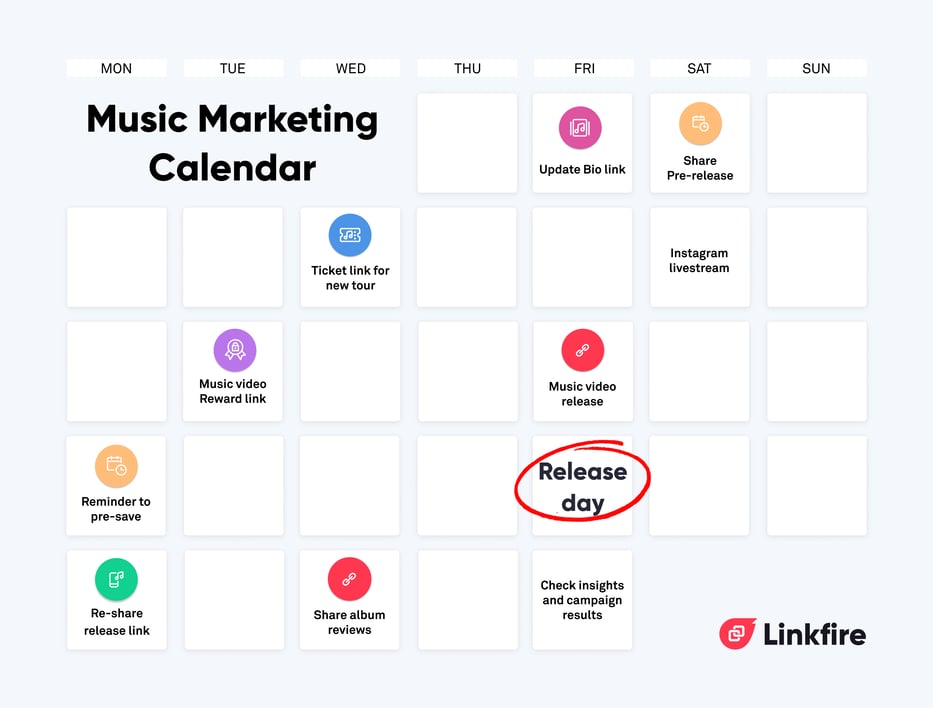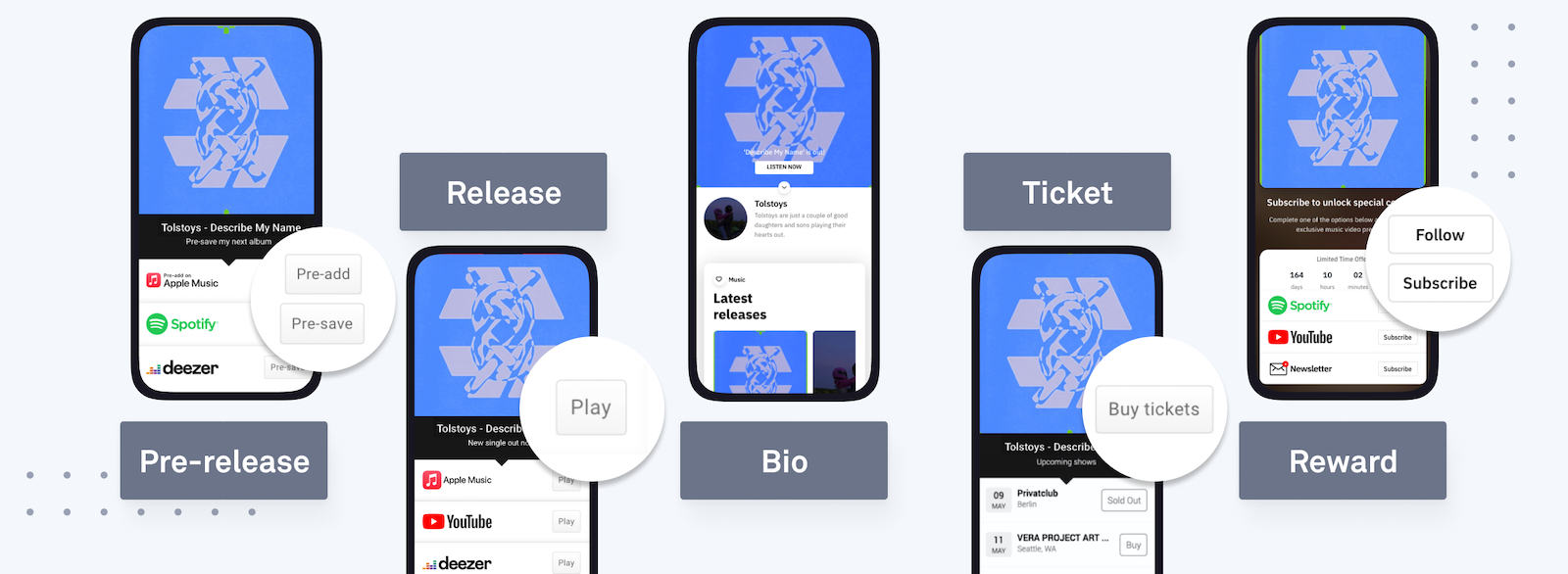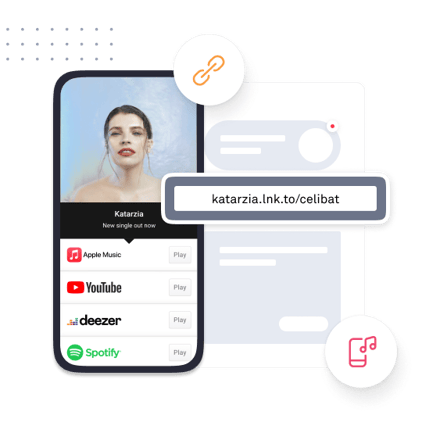The big moment has arrived: You’ve completed your latest musical masterpiece and you’re ready to unleash it onto the world. But before that happens, you need a music release marketing plan—no matter what level you’re at in your career.

Obviously, a music marketing plan doesn’t come together overnight. Start planting the seeds months in advance. In many cases, sooner is much, much better, especially if some of your plans involve time-sensitive elements. Identifying your target audience and growing your fanbase is also crucial so that when you’re ready to announce your new album, you already have a community that’s excited about it.
If you’re ready to get started on your music release plan, follow these eight steps to make it happen.
1. Decide on your music marketing goals
What do you actually want to accomplish with your music release? Your goals are entirely your own, and they can of course change over time. As a starting place, think about what you value most in your music career now. Once upon a time, a goal might have been to sell X copies of an album by release day, but now your goal may be getting playlisted X times. (More on that later!)
The key to setting goals for your music release plan is to be as specific as possible. Also, think about your brand: the more defined your artist brand is, the easier your marketing decisions will be.
A tried-and-true way to create and focus on goals is the SMART method:
- Specific: Get granular and use real numbers and deadlines as opposed to general goals. For example, instead of aiming to “get more people to watch my music video,” decide on a target number of people you’d like to watch your video, then develop a plan of action.
- Measurable: The importance of tracking and measuring your goals cannot be overstated, which is why we’re going to dive into it in-depth in a moment! The key when establishing your goals is to not fall into the trap of measuring vanity metrics—statistics that can look great, but aren’t actually evidence of success and don’t inform the direction of your overall music marketing strategy (think: social media likes, reach, or email open rates).
- Attainable: Getting on the cover of Rolling Stone might not be realistic depending on where you are in your career. But getting a write-up on that hip indie music blog could completely be within your reach. Keep in mind what’s actually possible when establishing your goals. This doesn’t mean you shouldn’t aim for the stars; it’s always worthwhile to try and push yourself towards something that might be just out of your reach. Just make sure there’s some feasible chance of actually achieving it before going all in to make it happen.
- Relevant: It might seem like a no-brainer to make your music release plan relevant to your goals as a musician, but by asking yourself why you’re making something a priority, you might discover that it’s actually not helping you in the big picture. For example, if you’re thinking about pouring your budget into manufacturing physical CDs, but you don’t know how to distribute them or which press contacts should receive them, this should probably not be one of your top priorities. Spend that time, energy, and money on something that is clearly aligned with release goals and, in the long term, your music career.
- Time-bound: Deadlines are crucial to a music release plan—not only during each step of the rollout, but for the overall plan itself. At some point (and you get to decide when that is, whether it’s six months, a year, two years, etc. from now), this music release plan will be over. Figure that out before you even begin.
2. Set a music release budget
Let’s bust a myth right up front: You can successfully promote your release on any budget. Just because you don’t have the resources of a major label artist doesn’t mean that your music marketing plan can’t be robust and amazing. The key is prioritizing the budget you do have, because that will get you farther than comparing yourself to artists with gigantic budgets behind them.
Your budget is going to be tailored to whatever goals you set above, but in general, it’s a good idea to include paid ads on social media. If you’re not sure how to go about marketing your release, this is an excellent place to start. Tweaking and scaling paid ads is incredibly easy, as is targeting them. Experiment a little bit and see what works best, then devote more of your budget to boosting it.
3. Track absolutely everything

As we mentioned before, one of the most crucial parts of your music release plan is actually figuring out what’s working and what’s not. Analyzing your album release is definitely one of the least sexy aspects of a music career, but it’s absolutely paramount to make your next campaign even better.
In order to analyze everything in the end, you need to set yourself up for success at the very beginning. Fortunately, this doesn’t have to be a stressful or time-consuming part of your process. Many social media platforms have some level of analytics built right into their dashboards, as do email newsletter systems. And by wrapping every link you share in a trackable Linkfire link, you’ll be able to collect a gold mine of cross-platform data points such as channels, clicks, streams, and follows, all in one place.
Smart links aren’t just for when your release comes out; in fact, they’re super important during the entire album release rollout. Linkfire offers seven types of smart links that can expertly inform not only how you track your music release, but also your entire plan—and, in turn, your music promotion strategy at large.
4. Define your key marketing channels and tactics for each
If you’ve been at this music thing for more than a minute, you know where your marketing strengths lie and more or less what works to communicate with your audience. When it comes to choosing how to work your channels around your music release, work with what you’ve got—your existing team, budget, or platforms on which you’re particularly strong. Focus on a small handful of channels that you can really commit to, rather than spreading yourself too thin trying to do everything and be everywhere.
For example, if your listeners are active and engaged on your Instagram, focus on creating a set of tactics for your album release on that platform, rather than deciding this is the time to launch your TikTok or Twitch. (Not that those can’t come later; but for now, stick within your marketing comfort zone.)
What you use to promote your release on those channels depends on your own unique artist brand and what you know speaks to your audience. Incorporate your smart links across your marketing channels to ensure you’re hitting all angles, and make it easy for your fans to engage with your music rollout plan. Like…
5. Drop singles first to generate interest
Let the real fun begin! Actually unleashing your music is inarguably the best part of any music release plan. How you go about it can be as strategic as you want it to be. Do you want to give fans a little teaser in the form of an album “trailer”? What about going live on Instagram to premiere your new song in person? Or maybe you have a strong enough fanbase that you can try dropping an entire EP overnight and seeing what happens.
Historically, singles have led the pack when it comes to music releases, and the same is pretty true today (although the mediums have changed). YouTube is commonly a premiere platform for singles in the form of music or lyric videos. Use a direct-to-service release link to capture YouTube streaming insights on your first single to help inform the rest of your music marketing strategy, including any follow-up singles and drops on other streaming platforms.
6. Launch a music release pre-save campaign
About 30-90 days before release day, you’ll want to start kicking things into high gear. One way to get a jumpstart is through a pre-save campaign, which is basically a way to incentivize your listeners to “pre-save” (kinda like a physical media pre-order) your music on streaming services. It’s easy to create a Linkfire pre-release link that directs your listeners to save your music not only on Spotify, but also on Apple Music, Amazon Music, and Deezer.
Then, on the day of its release, your music will be directly delivered to those who pre-saved. The benefit for you is that it helps boost your presence on each streaming platform through plays and traction, which might translate into getting featured on curated or organic streaming playlists.
7. Release your music!
Obviously, this is the most exciting step and the culmination of all your hard work and planning. But it can also feel pretty overwhelming and stressful. Will people actually listen? If they haven’t yet pre-saved your music, how will you spread the word most efficiently?
One key way to eliminate that stress and easily direct people to your new music is by using a release link to promote your new single or album. (Pro tip: If you’ve already set up a Linkfire pre-release link, it’ll automatically convert to a regular release link on whatever date you set!)
No matter what platform or format your listeners use to consume music, they’ll be quickly linked to it via one simple, streamlined link. Not only does that make it easy for you to share with virtually anyone and everyone, but it makes your listeners’ lives easier and provides them with what they really want—your tunes!
Build even more momentum after release day by performing a show or live streaming a music release party. In the week after your release, update your landing page to direct fans to an upcoming live stream, like this. Linkfire landing pages are totally customizable, so you can add details or anything your attendees need to know about your stream.
8. Keep the buzz going for your album release
It’s not over yet! Keep driving listeners to your album release by shaking up your content or promoting your music in new and different ways. If your music ends up on a playlist, or if you’ve scored an awesome write-up on a blog, be sure to share the news with a content link or playlist link to maximize your exposure to new ears.
This is also the perfect time to set up a Linkfire reward link and give your fans instant access to secret content, a coupon code, or a contest. Consider sending out an email newsletter offering an exclusive merch discount, or launch a social media giveaway for physical copies of your music or special promo items.
No matter which music promotion strategies you go with, keep an eye on your Linkfire Insights to make smarter marketing decisions as you continue your release rollout.
Final thoughts
Although you’re constructing your music release plan far before your music actually comes out, it’s totally okay to tweak your plan along the way. After all, the music industry is changing all the time. Something that worked for you six months ago might not work anymore, or you might find yourself with different opportunities than you thought you’d have.
Remember that your marketing plan is for you and your music, so make sure that it’s actually useful and serving your needs.

Ready to put these tips to use?
Get eye-catching smart links and landing pages to use in all your marketing efforts with Linkfire.
Get Linkfire’s curated tips straight to your inbox and become smarter in music marketing. Subscribe to our newsletter.

